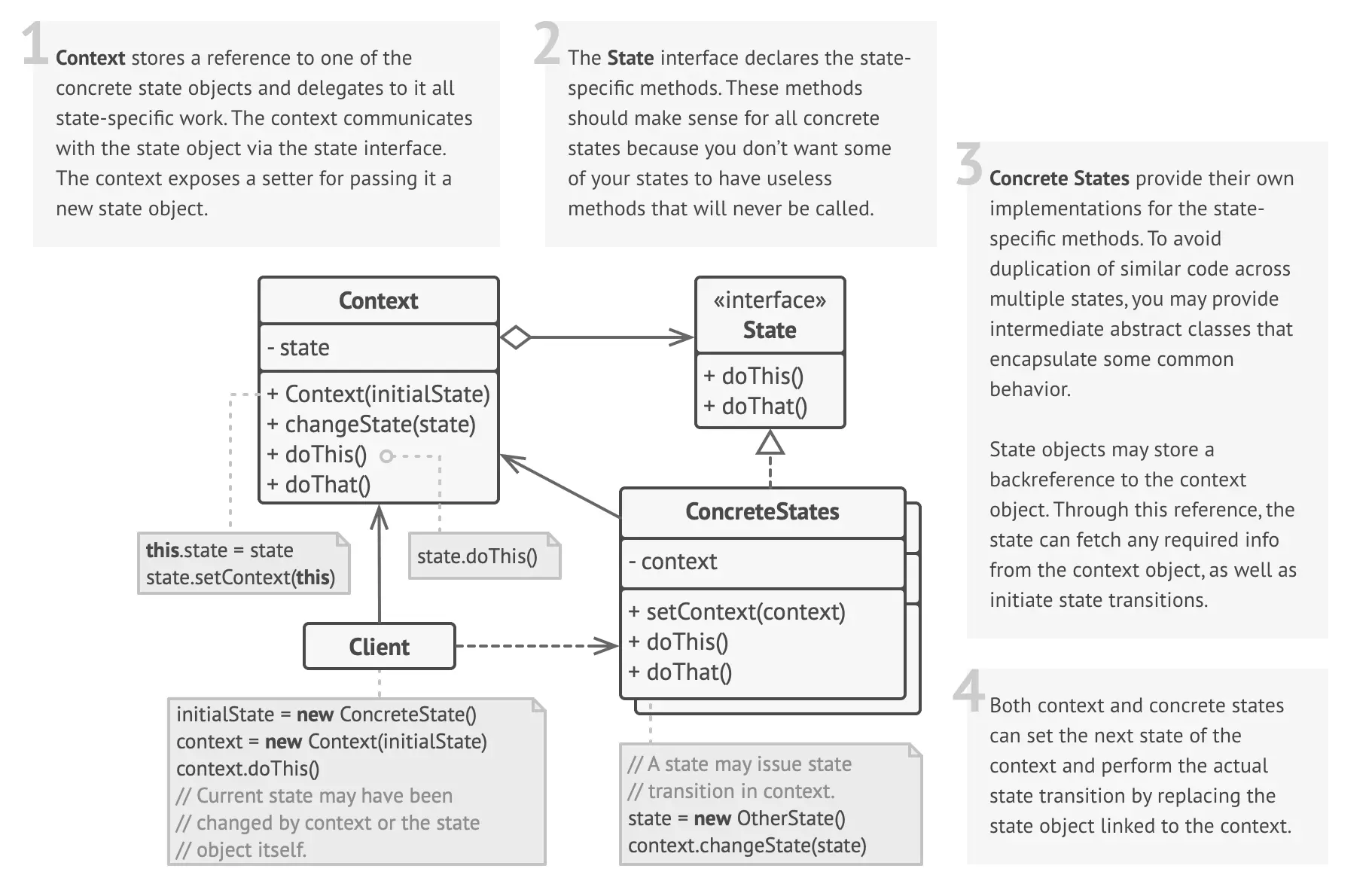Software Design - State Pattern
Explore the State Pattern, its structure, use cases, and benefits in software design.
Software Design - State Pattern
Definition
Imagine a TV remote:
- Off (❌): Press power ➔ TV turns on.
- On (✅): Press power ➔ TV turns off.
- Mute (🔇): TV is silent; pressing mute brings back the sound.
The State Pattern is a behavioral design pattern that allows an object to change its behavior based on its internal state.
Instead of using many if-else conditions, behavior is delegated to state-specific classes.
Structure
 State Pattern Structure taken from Refactoring Guru
State Pattern Structure taken from Refactoring Guru
- Encapsulate state-specific behavior into separate classes.
- State objects handle transitions between states.
- Allows dynamic behavior changes at runtime.
- Follows the Open/Closed Principle: Easily add new states without modifying existing code.
Key Characteristics
- Encapsulates State-Specific Behavior ➔ Organized code with each behavior in its own class.
- State Objects Handle Transitions ➔ Context object doesn’t manage transitions; states do.
- Allows Dynamic Behavior Changes ➔ Switching states changes behavior dynamically.
- Open/Closed Principle Compliance ➔ Add new states easily without changing existing code.
When to Use
✅ Complex State-Dependent Behavior
- Ex: Document editor in Draft, Review, Published states.
✅ Eliminating Large Conditionals
- Ex: Vending machine with states like Idle, HasMoney, Dispensing.
✅ State-Specific Operations
- Ex: Media player handling Playing, Paused, Stopped.
✅ Runtime State Changes
- Ex: Phone switching between Normal Mode, Battery Saver Mode.
When NOT to Use
❌ Simple State Transitions
❌ Resource Constraints (due to extra classes/objects)
❌ Unpredictable State Changes
❌ Centralized State Transition Logic
❌ Short-Lived Objects (no meaningful state change during lifespan)
Code Example
1
2
3
4
5
6
7
8
9
10
11
12
13
14
15
16
17
18
19
20
21
22
23
24
25
26
27
28
29
30
31
32
# State Interface
class OrderState:
def proceed(self, order):
raise NotImplementedError("Subclasses must implement this!")
# Concrete States
class ReceivedState(OrderState):
def proceed(self, order):
print("Order received. Now processing the order.")
order.state = ProcessingState()
class ProcessingState(OrderState):
def proceed(self, order):
print("Order is being processed. Now dispatching the order.")
order.state = DispatchedState()
class DispatchedState(OrderState):
def proceed(self, order):
print("Order has been dispatched. Delivery in progress.")
# Final state; no transition here.
# Context
class Order:
def __init__(self, state: OrderState):
self.state = state
def next(self):
self.state.proceed(self)
# Demonstration:
if __name__ == '__main__':
order = Order(ReceivedState())
order.next() # Transitions from Received to Processing.
order.next() # Transitions from Processing to Dispatched.
order.next() # No further transition
Real World Examples
- Vending Machine
- System: Vending Machine
- Interface: VendingMachineState
- Concrete States: IdleState, HasMoneyState, DispensingState, OutOfStockState
- Context: VendingMachine
- Video Game Character
- System: Video Game Character
- Interface: CharacterState
- Concrete States: IdleState, RunningState, AttackingState, DeadState
- Context: GameCharacter
- Chat App User Presence
- System: Chat App User Presence
- Interface: PresenceState
- Concrete States: OnlineState, OfflineState, AwayState, BusyState
- Context: UserPresence
- ATM Machine
- System: ATM Machine
- Interface: ATMState
- Concrete States: NoCardState, HasCardState, AuthorizedState, NoCashState
- Context: ATMMachine
- Elevator System
- System: Elevator System
- Interface: ElevatorState
- Concrete States: IdleState, MovingUpState, MovingDownState, DoorOpenState
- Context: ElevatorController
- Document Workflow System
- System: Document Workflow System
- Interface: DocumentState
- Concrete States: DraftState, ReviewState, PublishedState, ArchivedState
- Context: Document
- E-commerce Product Lifecycle
- System: E-commerce Product Lifecycle
- Interface: ProductState
- Concrete States: NewProductState, ActiveState, DiscontinuedState
- Context: Product
- Printer Job Management
- System: Printer Job Management
- Interface: PrintJobState
- Concrete States: QueuedState, PrintingState, CompletedState, ErrorState
- Context: PrintJob
This post is licensed under CC BY 4.0 by the author.